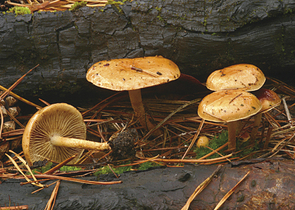Nature Conservation 1/2011 — 11. 4. 2011 — Research, Surveys and Data Management — Print article in pdf
The Havraní skála/Rook Rock near the Village in the České Švýcarsko/Bohemian Switzerland National Pa
vývoj flóry a fauny na ploše zasažené požárem

On June 22, 2006, a massive fire had broken out on the Havraní skála/Rook Rock in the České Švýcarsko/Bohemian Switzerland National Park. In total, 17.92 hectares of forests, consisting mostly of the Scots Pine (Pinus sylvestris) with rarely dispersed Sessile Oak (Quercus petraea) and European or Common Beach (Fagus sylvatica) were burnt as well as the White Eastern Pine (Pinus trobus) plantations located on northern and north-western slopes.
The area had been left to spontaneous development. In autumn 2006, 13 fungi species, of them 60% anthracophilous, were found there. Rutstroemia carbonicolawas the most remarkable, because it was described in South Bohemia only in 1979. In spring 2007, mosses predominated at the site, but the first tree species seedlings have also appeared. In autumn 2007, 37 fungi species, of them 22% anthracophilous, were recorded there. The scene of a fire was overgrown by dense self-sowing of seedlings and juvenile individuals of the following tree species: Pine (Pinusspp.), the Common Aspen (Populus tremulus), birch (Betulaspp.) and the Goat Willow (Salix caprea) were the most common. Tree species composition dramaticall changed in 2008. The Common Aspen has become the most common, followed by birch, the Scots Pine and the Goat Willow. Fungi community composition has also changed: the number of anthracophilous species declined, while on the other hand that of mycorrhizal ones has increased, because the latter often follow pioneer tree species.

